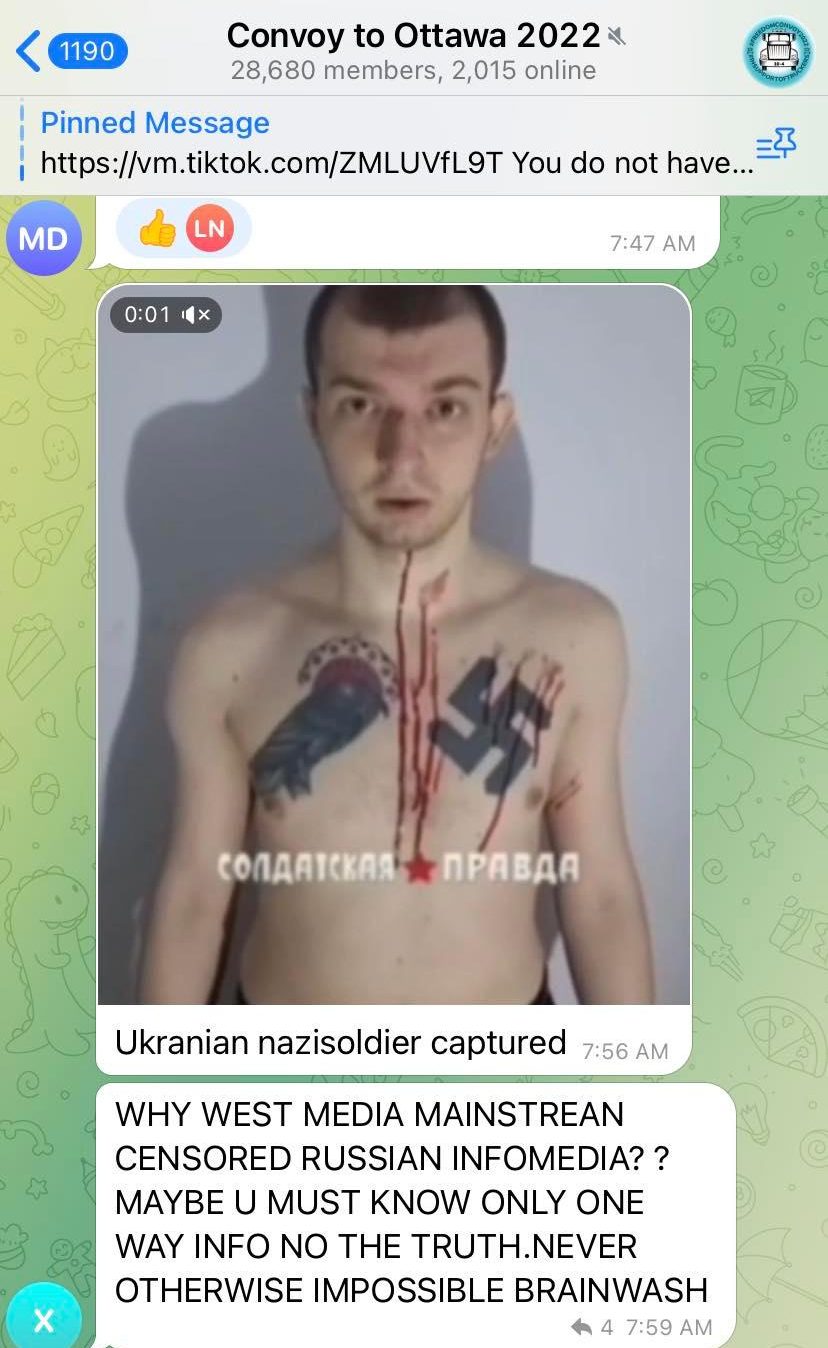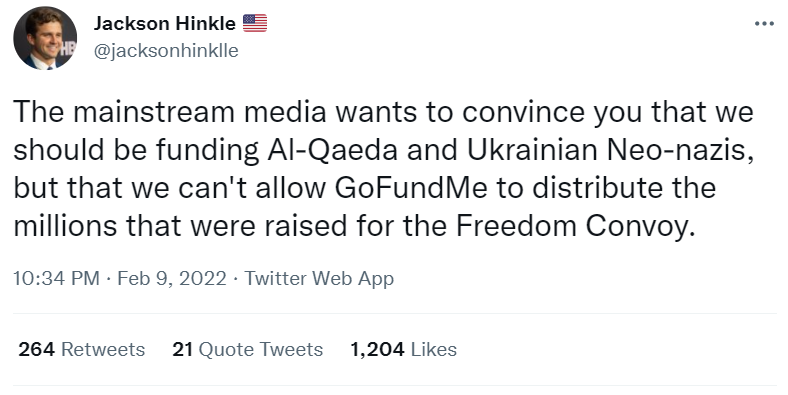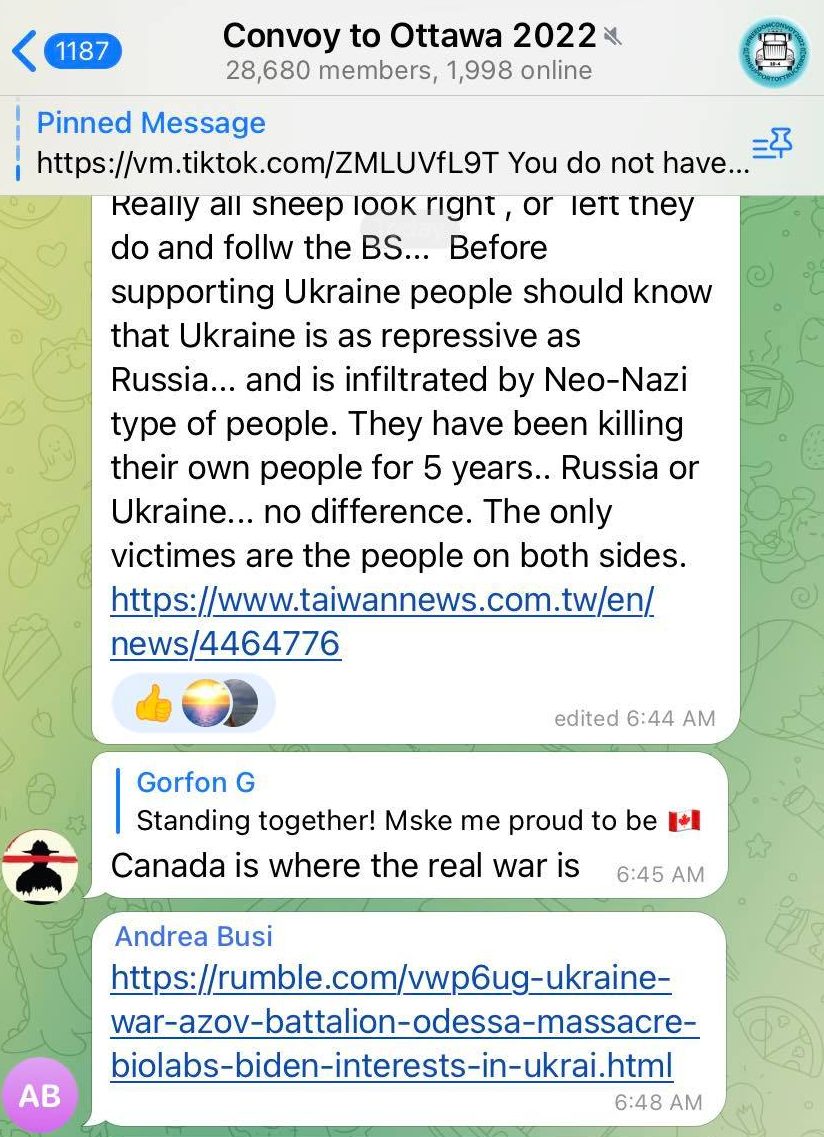As the tire tracks fade from the so-called “freedom convoy” that occupied downtown Ottawa streets, some of the Telegram forums devoted to the convoy have taken up the torch of a new cause: Russia’s invasion of Ukraine.

Much like the misinformation that fueled some of the trucks headed for Ottawa, conspiracy theories are at the core of some of their conversations about Ukraine — leading them to decry Western intervention in the conflict, or in some cases, express outright support for Russia.
“I fully support Russia,” wrote one Telegram user in the channel titled Convoy to Ottawa 2022, which has just shy of 30,000 subscribers.
In another post on the channel, a user addresses the Russian military: “We, the Russian residents of Kiev, are waiting for you. But be careful, there are a lot of hostile people here. And outright enemies and simply deceived by propaganda.”
It can be difficult — if not impossible — to ascribe motivations to the people participating in these forums, disinformation experts say. But one thing is clear: some pro-convoy forums have shifted from posting misinformation about COVID-19 to posting misinformation about the Russia-Ukraine war.
“It is definitely a trend that is happening,” said Carmen Celestini, who is a post-doctoral fellow with the Disinformation Project at Simon Fraser University.
“I mean, we can see images where they’re posting pictures of the mall in Ukraine with a swastika in the background and sort of supporting this narrative of Putin’s, that he’s de-nazifying Ukraine.”

Celestini was referring to an LED display at a Ukrainian mall that lit up with a swastika in 2019. The mall quickly took the image down and apologized, saying in a Facebook post that it had been hacked. However, images like the hacked mall LED display — presented without context — can be used to bolster Russian President Vladimir Putin as he continues to justify his invasion of Ukraine as an attempt to “de-nazify” the region.
Pro-convoy accounts and misinformation about Russia
If you press the “join” button on Telegram channels created for the convoy that occupied Ottawa for weeks, you’d be forgiven for thinking you’re in the wrong place. Two channels, Convoy to Ottawa 2022 and Global Freedom Convoy, have been inundated with messages about Russia’s invasion of Ukraine, rather than the anti-mandate convoy they were created to support.
Between the two accounts, those messages — many of which are sympathetic to Putin — reach an audience over 48,000 members.
One very popular post circulating on both forums suggests that Putin is simply invading Ukraine in order to destroy U.S.-run bioweapon labs in the region.
“Russia Produces Documents Showing US-Funded Bioterror Labs in Ukraine Producing Anthrax and Plague,” reads the headline of one article shared in the Global Freedom Convoy channel.
Another user posts that “in Ukraine since 2012, the US government has created dozens of biological laboratories…I think that’s where Covid19 was invented. Now, when the Russians are liberating these laboratories, a lot of interesting things come up.”
This disinformation about U.S. bioweapons manufacturing has been debunked.
There have also been a number of posts on the convoy Telegram channels parroting Putin’s false assertion that Ukraine is controlled by Nazis.

Get daily National news
“The most popular disinformation that is spreading is that Ukraine is full with a bunch of Nazis,” said Mary Blankenship, a University of Nevada researcher who looks at how misinformation spreads through Twitter.
“This is sort of, kind of how they’re aligning themselves with Putin, because they’re making the statement that Canada’s government is filled with a bunch of Nazis, and (is) oppressing the people, and at the same time are supporting Nazis in Ukraine.”
This rhetoric of Nazis in Ukraine is on full display on Telegram convoy chats, where one user posted an image that claims to show a captured Ukrainian solider with a swastika tattoo — and another posted a video of “foreign students” being held “hostage” by a “Ukrainian Nazi army.”
Putin’s “denazification” justification for the invasion of Ukraine has been widely rejected.
Still, the message seeps into conversations on other social media platforms and amplifies disinformation.
“The mainstream media wants to convince you that we should be funding Al-Qaeda and Ukrainian Neo-nazis, but that we can’t allow GoFundMe to distribute the millions that were raised for the Freedom Convoy,” said one user, who has 29,000 followers.
Another narrative that can be seen frequently in convoy circles is the allegation the war is simply intended as a distraction from the “tyranny” here in Canada.
Blankenship said, especially before Russia actually invaded Ukraine, a common comment among convoy supporters she studied on Twitter was that the “impending invasion that was going on was just a distraction” and that the “real war that’s going on is in Canada.”
This “distraction” theme is still evident in the pro-convoy Telegram channels.
“Canada is where the real war is,” said one user in the Convoy to Ottawa 2022 channel.
“War in Ukraine is a Great Reset distraction,” wrote another user, citing the widely debunked theory that details a vague “they” or a generally nameless “global elite” conducting looming, ominous power grabs around the world.
Not everyone is thrilled with the new direction of the convoy Telegram channels, however. Some users expressed their frustration with all the posts about Russia and Ukraine, pleading with their fellow users to stay true to the chat room’s original purpose.
“Wish this channel was still focused on the truckers and the people of THIS country,” one user wrote.
Why is this happening?
It can be difficult to assign a motivation to each user of an online forum that shares false information — knowingly or unknowingly, Celestini said.
“We can’t honestly say how many of these are genuine convoy people who are on Telegram, or who are bots, or who are just, for lack of a better term, s–t disturbers,” Celestini said.
However, early research indicates Russia has been deploying its pro-Putin disinformation networks across the internet. According to a recent report from the counter-disinformation group Mythos Labs, Russia seriously cranked up its legion of bots since November of last year.
Mythos Labs identified 58 accounts spreading pro-Russian disinformation and propaganda about Ukraine in November. Between Jan. 5, 2022, and Feb. 28, 2022, they found 914 of them.
“The volume of Ukraine-related tweets by accounts spreading pro-Russian disinformation/propaganda also increased by over 1,000 per cent during the last two weeks of February,” the report said.

Blankenship said there are “undoubtedly” a “lot of bots and troll accounts that are present” in the spaces where misinformation about Ukraine is being shared.
“But I would say there’s still real people that believe this kind of disinformation and misinformation. So it’s a pretty big mix,” she said.
While people fall prey to disinformation for a variety of reasons, Celestini said she noticed one large area of overlap between pro-convoy accounts and pro-Putin accounts: their belief in conspiracy theories, namely in QAnon.
QAnon is a big-tent conspiracy theory that can be interpreted in a number of ways, according to Celestini. At its core, however, the completely unfounded theory claimed former U.S. President Donald Trump was waging a secret war against elite Satan-worshipping pedophiles in government, business and the media, the BBC explains.
With the advent of the COVID-19 pandemic, the conspiracy’s umbrella broadened to include accusations this shadowy global elite planned and managed the pandemic in the name of ushering in a “Great Reset.”
“(There’s) this idea that they’re taking over our government and bringing this New World Order, (and) there’s a hero here that could stop that from happening: Putin,” Celestini explained.
“They don’t want the West to get involved.”
How can you identify Russian misinformation?
More and more of the misinformation that’s circulating these days is “a personal attack to Ukrainians … as a people and as a culture,” Blankenship said.
To make sure you’re not sharing it, there are some simple steps you can take. First, check the source.
“Try to find the original source, or look at news from local sources in Ukraine (like) Kyiv Independent. There’s also a few other independent sources in Ukraine that can give you the most up-to-date information about the situation,” Blankenship said.
“If you can’t find that, then I would say back away from what you’re seeing.”
It’s important not to take everything you see at face-value, Blankenship said. And there are some tools that can help you navigate that.
MediaSmarts has developed a custom fact-checker search engine, which you can use to Google something you saw. All the results will be from verified fact-checkers. There’s also a tool that will tell you the likelihood that an account is a bot.
If you do find something you suspect is misinformation or disinformation, Blankenship said, you should report it.
And whatever you do, try not to interact with the false information, because that means algorithms will likely boost its reach.
“That’s really important. … It doesn’t matter whether your agree or disagree with the post. You’re still perpetuating its spread,” Blankenship explained.

And whether they’re driven by baseless conspiracy theories, Russian bots or simply misinformed citizens, these false narratives have a real impact on people living in Ukraine, some of whom are Blankenship’s relatives.
“You have enough people believing it, you’ll have people not support any of the government attempts to provide Ukraine with aid, whether that’s financial, military, or medical aid,” she said.
That, she said, is a “really huge and important impact that disinformation can have.”











Comments